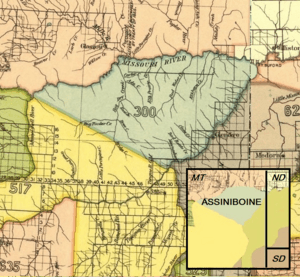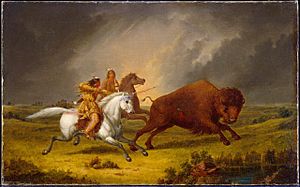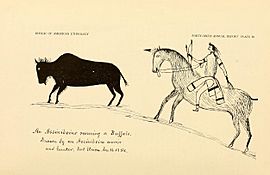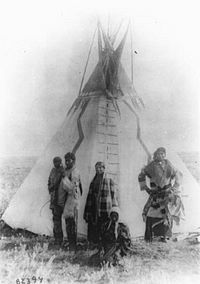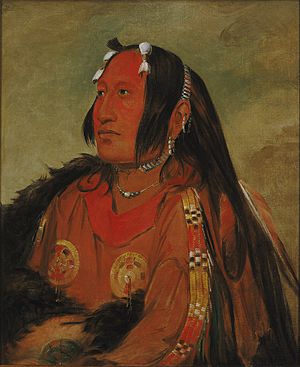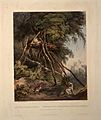Assiniboine facts for kids
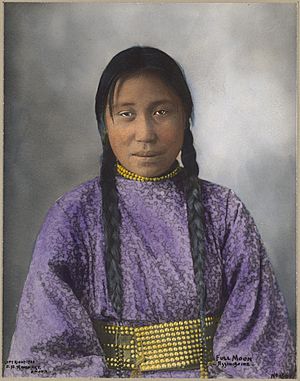
Full Moon, an Assiniboine woman, 1900
|
|
| Total population | |
|---|---|
| 3,500 | |
| Regions with significant populations | |
| Canada (Manitoba, Saskatchewan and Alberta) United States (North Dakota and Montana) |
|
| Languages | |
| Assiniboine, English | |
| Religion | |
| traditional tribal religion, Sun Dance, Native American Church, Christianity |
|
| Related ethnic groups | |
| Dakota, Stoney |
The Assiniboine people, also known as the Hohe or by their own name Nakota, are a First Nations/Native American group. They originally lived in the Northern Great Plains of North America.
Today, most Assiniboine live in Saskatchewan, Canada. They also live in parts of Alberta and southwestern Manitoba in Canada. In the United States, they live in northern Montana and western North Dakota. The Assiniboine were well-known in the late 1700s and early 1800s. They were important members of the Iron Confederacy alongside the Cree people. Famous artists like Karl Bodmer and George Catlin painted pictures of Assiniboine people in the 1800s.
Contents
Names of the Assiniboine
Europeans and Americans first used names for the Assiniboine that other tribes used. They later learned the tribe's own name for themselves, which is Hohe Nakota. However, the name "Assiniboine" became common in English. This name came from the Canadian French colonists. They heard the Ojibwe people call them asinii-bwaan, which means "stone Sioux." The Cree people called them asinîpwâta, meaning "stone enemy" or "stone Sioux."
The word "stone" was often linked to the Assiniboine because of their cooking methods. They would heat stones and drop them into water to make it boil. This helped them cook meat.
Language of the Assiniboine
The Assiniboine language is part of the Western Siouan language family. Today, about 150 people still speak the language, and most are over 40 years old. Most Assiniboine people now speak only American English. In the year 2000, about 3,946 tribal members lived in the United States.
The Assiniboine are closely related by language to the Stoney First Nations people in Alberta. Both tribes speak forms of Nakota. This language is related to the Sioux language, but they are not exactly the same.
History of the Assiniboine
Early Times
The Assiniboine, along with the Stoney people, share ancestors with the Sioux nation. It is believed that the Assiniboine separated from the Sioux before 1640. At that time, a French writer named Paul Le Jeune mentioned them alongside the "Naduessi" (Sioux).
The Ojibwe people, who had guns from their French friends, gradually pushed the Assiniboine and Sioux westward. This moved them from the woodlands of Minnesota onto the plains. Later, the Assiniboine got horses by trading or raiding with nearby tribes like the Crow and Sioux.
The Assiniboine became a large and powerful group. They became skilled horse riders and warriors. They used horses to hunt the many bison (buffalo) that lived in their lands. When they were strongest, the Assiniboine controlled a huge area. This land stretched from the North Saskatchewan River in the north to the Missouri River in the south. It included parts of modern-day Saskatchewan, Alberta, and Manitoba in Canada, and North Dakota and Montana in the United States.
Meeting Europeans and Fur Trade
The first European to write about the Assiniboine was Henry Kelsey in the 1690s. He worked for the Hudson's Bay Company. Later explorers and traders also confirmed that the Assiniboine held a large territory across the northern plains.
The Assiniboine became important trading partners for fur traders and other Native American groups. They traded with British companies like the Hudson's Bay Company and North West Company in Canada. In the United States, they traded with the American Fur Company. The Assiniboine traded furs, especially beaver and bison hides. In return, they received guns, ammunition, metal tools, blankets, and glass beads.
Sadly, increased contact with Europeans also brought new diseases. Many Assiniboine people became sick from illnesses like smallpox, which they had not been exposed to before. This caused their population to drop from about 10,000 people in the late 1700s to around 2,600 by 1890.
The Lewis and Clark Expedition explored the new Louisiana Territory for the United States in the early 1800s. Their journals mention the Assiniboine, but the explorers did not meet the tribe directly.
Famous European and American painters, like Karl Bodmer, Paul Kane, and George Catlin, traveled to the West to paint Native American peoples. They met and painted the Assiniboine from real life.
The Assiniboine signed the Treaty of Fort Laramie (1851). In 1885, some Assiniboine scouts helped Canadian forces find Cree warriors during the North-West Rebellion.
Interactions with Other Tribes
In 1857, a group of Sioux warriors, including Sitting Bull, attacked an Assiniboine camp. A young 11-year-old boy bravely fought back. Sitting Bull was impressed by the boy's courage and decided to adopt him as his brother. The boy was named Jumping Bull and remained loyal to Sitting Bull. He later passed away defending Sitting Bull in 1890.
The Iron Confederacy
The Assiniboine were a big part of a strong alliance of northern Plains Indian nations called the Iron Confederacy. This alliance lasted from before 1692 until the late 1800s. The Iron Confederacy worked together in the fur trade, especially with the Hudson's Bay Company. The Assiniboine and the Cree were important go-betweens in the trading networks of the Great Plains.
Other members of the Confederacy included the Stoney, Plains and Woodland Cree, Saulteaux, Plains Ojibwe, and Métis people. Some Iroquois who worked for fur traders also joined. Plateau tribes like the Bitterroot Salish (Flathead), Kutenai, Sekani, Secwepemc, and Nez Perce were also loosely connected. Sometimes, other Plains peoples like the Gros Ventre were part of the group too.
The Confederacy became very powerful on the northern plains. They were a threat to other tribes not in the alliance, such as the Shoshone and Crow. Their strongest enemies were the Blackfoot Confederacy, who used to be their trading partners. The Sioux peoples and their friends, the Arapaho and Cheyenne, were also enemies. The Iron Confederacy also attacked European-American settlements.
The Confederacy eventually declined because the fur trade slowed down. Also, Canadian and American hunters overhunted the bison herds, which was the main food source for these nations. This led to the breaking up of the Confederacy. They also fought with Canada during the North-West Rebellion.
Traditional Lifestyle
Traditionally, the Assiniboine were nomadic, meaning they moved from place to place. In warmer months, they followed and hunted herds of bison (buffalo).
Women had a very important role in the tribe. They were responsible for the family's survival and the future of the tribe. Women gathered plants and herbs, used them for medicine, and cared for children and elders. They also made clothing and tools. They processed and preserved meat and skins from hunted animals. Every part of the animal was used.
Men hunted, traded, and went to war on horseback using bows and arrows. The Assiniboine were known for being excellent horse riders. They first got horses by trading with the Blackfeet and Gros Ventre tribes. Assiniboine girls were encouraged to learn to ride, hunt, and fight. While men usually fought in wars, women sometimes fought too, especially if the tribe was in great danger.
They also worked with the Mandan, Hidatsa, and Arikara tribes.
The Sun god and Thunder god were seen as the most important parts of the Great Spirit. The Assiniboine people took part in the Sun Dance, like other Plains Native peoples. They also sought guidance from personal visions during Vision Quests.
The Assiniboine Nation was historically divided into many separate bands. Each band was led by a Hųgá (chief) and a council of advisors. Other important people included the įtą́cą (war chief), who led warriors, and the Wócegiye įtącą (medicine man), who was a religious leader and healer. News and decisions were announced by the Hogíyesʾa (Camp Crier). The Agícida (Soldier or Camp Watcher) acted as "police" to keep order in the camp, during hunts, and in war.
Each band was divided into smaller Tiʾóšpaye (local groups), which were made up of several extended families. The smallest group was the Tiwáhe (nuclear family), which usually lived in one or two tipis.
The Assiniboine are a patrilineal tribe. This means that leadership and family lines pass through the father's side. Children are considered part of their father's family group.
Mythology
The character of Iktome is very famous in Assiniboine creation myth. Iktome is a creator and trickster figure. In one myth, Iktome sends animals to find land under a deep, ancient sea. Only the muskrat succeeds, floating to the surface dead with earth in its paws. Iktome uses this earth to create land. Unlike some other creators, Iktome is not always good. He can be tricky. For example, he kills a frog who challenges his plan for an endless winter, but then he agrees to shorten winter to seven months. He also creates horses and humans from dirt and teaches the Assiniboine how to steal horses. Some parts of these myths, like the presence of horses, were added later after horses were brought to North America by the Spanish.
Subgroups and Bands
The Assiniboine people were made up of many different groups or bands. Here are some of them:
- Aegitina ('Camp Moves to the Kill')
- Bizebina ('Gophers' or 'Gopher People')
- Cepahubi ('Large Organs')
- Canhdada ('Moldy People', lived near the North Saskatchewan River)
- Canhewincasta ('Wooded-Mountain People' or 'Wood Mountain People', lived around Wood Mountain)
- In 1873, two bands led by chiefs Manitupotis and Hunkajuka were attacked in the Cypress Hills massacre. About 25 to 30 Assiniboine were killed by American wolf hunters. This event led to the creation of the North-West Mounted Police (NWMP), which is now the Royal Canadian Mounted Police (RCMP).
- Canknuhabi ('Ones That Carry Their Wood')
- Cantonga ('Forest Villagers, Wood Villagers'), also known as Swampy Ground Assiniboine. They developed into the Wood Stoney-Nakoda.
- Hudesabina ('Red Bottom' or 'Red Root', split from the Wadopabina Band). They live in northern Montana and southern Alberta.
- Hebina ('Rock Mountain People'), often called Strong Wood Assiniboine. They moved into the Rocky Mountains to avoid smallpox and became the Mountain Stoney-Nakoda.
- Hen atonwaabina ('Little Rock Mountain People', lived in the Little Rocky Mountains in Montana).
- Huhumasmibi ('Bone Cleaners')
- Huhuganebabi ('Bone Chippers')
- Indogahwincasta ('East People')
- Inninaonbi ('Quiet People')
- Insaombi ('The Ones Who Stay Alone', lived in Cypress Hills). They were also called the Cypress Hills Assiniboine.
- Inyantonwanbina ('Stone / Rock People', 'Mountain People'). They became the Nakoda (Stoney) people.
- Minisose Swnkeebi ('Missouri River Dog Band', lived near the Missouri River).
- Minisatonwanbi ('Red Water People'), lived along the Red River of the North in Manitoba.
- Osnibi ('People of the Cold'), a group of Woodland Assiniboine.
- Ptegabina ('Swamp People')
- Sahiyaiyeskabi ('Plains Cree-Speakers'), also known as Cree-Assiniboine / Young Dogs. These were mixed bands of Plains Cree and Assiniboine who spoke Plains Cree.
- Sihabi ('Foot People'), also known as Foot Assiniboine. They became the Wood Stoney-Nakoda and Mountain Stoney-Nakoda.
- Snugabi ('Contrary People')
- Sunkcebi ('Dog Band').
- Tanidabi ('Buffalo Hip')
- Tokanbi ('Strangers')
- Tanzinapebina ('Owners of Sharp Knives')
- Unskaha ('Roamers')
- Wadopabina ('Canoe Paddlers'), also called Canoe Assiniboine.
- Wadopahnatonwan ('Canoe Paddlers Who Live on the Prairie'), also known as Big Devils or Gauche's Band.
- Waką́hežabina, also called Little Girls Band.
- Wasinazinyabi ('Fat Smokers')
- Waziyamwincasta ('People of the North').
- Wiciyabina ('Ones That Go to the Dance'), often called Girl Band.
- Wokpanbi ('Meat Bag')
Present Situation
Today, many Assiniboine people live with other tribes, such as the Plains Cree, Saulteaux, Sioux, and Gros Ventre. They live on several reservations in Canada and the United States. In Manitoba, Assiniboine people live as individuals and do not have separate communal reserves.
Montana, United States
- Fort Peck: About 11,786 Assiniboine and Sioux people live here. The reservation is in northeast Montana, covering about 8,518 square kilometers. The main office is in Poplar.
- Fort Belknap: About 5,426 enrolled Assiniboine and Gros Ventre people live here. Most live on the reservation in north central Montana, which is about 2,626 square kilometers.
In 2012, these two reservations received 63 American bison from Yellowstone National Park. These bison were released into a large game preserve. This was a special event because these bison are genetically pure, meaning they have not been mixed with cattle. Native Americans celebrated this as a step to bring back the bison, which were almost wiped out long ago.
Saskatchewan, Canada
- Carry the Kettle Nakoda First Nation: This reserve is in southeast Saskatchewan. About 850 of the 2,387 registered Assiniboine live on the reserve.
- Mosquito, Grizzly Bear's Head, Lean Man First Nations: Also known as Battleford Stoneys. This group includes several reserves south of Battleford. In 2003, there were about 1,119 registered Assiniboine.
- White Bear First Nation: This reserve is in the southeast corner of Saskatchewan. About 1,990 Assiniboine, Saulteaux, Cree, and Dakota people live here.
- Ocean Man First Nation: This reserve is north of Stoughton. About 170 of the 454 registered Assiniboine, Cree, and Saulteaux live on the reserve.
- Pheasant Rump Nakota First Nation: This reserve is near Kisbey. About 333 Assiniboine, Saulteaux, and Cree people belong to this group.
Namesakes
- A ship from Canada Steamship Lines was named CSL Assiniboine.
- Two trading posts were named "Fort Assiniboine," one in Manitoba (1793) and one in Alberta (1824).
- The Assiniboine River flows through much of Saskatchewan and Manitoba.
- Assiniboia refers to two historical districts in Canada's North-West Territories. The name comes from the Assiniboine First Nation.
Gallery
-
Black Eagle, Assiniboine man, 1908 photo by Edward Sheriff Curtis
Assiniboine People
- Hank Adams (born 1943), a leader for Indigenous rights
- Dolly Akers, a legislator from Montana
- Crazy Bear (1785–1856), a chief and negotiator
- Juanita Growing Thunder Fogarty (born 1969), an artist known for beadwork and quillwork
- Roxy Gordon (1945–2000), a poet, writer, musician, and activist
- Indigenous, a Nakota blues band
- Georgia Wettlin Larsen, a singer
- Wi-jún-jon (1796–1872), a chief
- William S. Yellow Robe, Jr. (born 1950), a playwright, author, and poet
- Jamie Fox, a Métis fiddle player
- David Midthunder, a TV and film actor, who is a member of the Fort Peck Sioux and Assiniboine Indian Reservation
See also
 In Spanish: Assiniboine para niños
In Spanish: Assiniboine para niños


